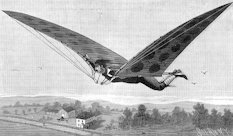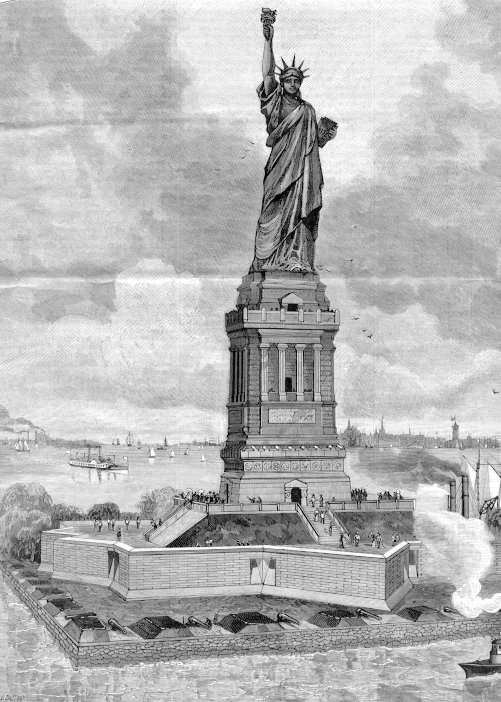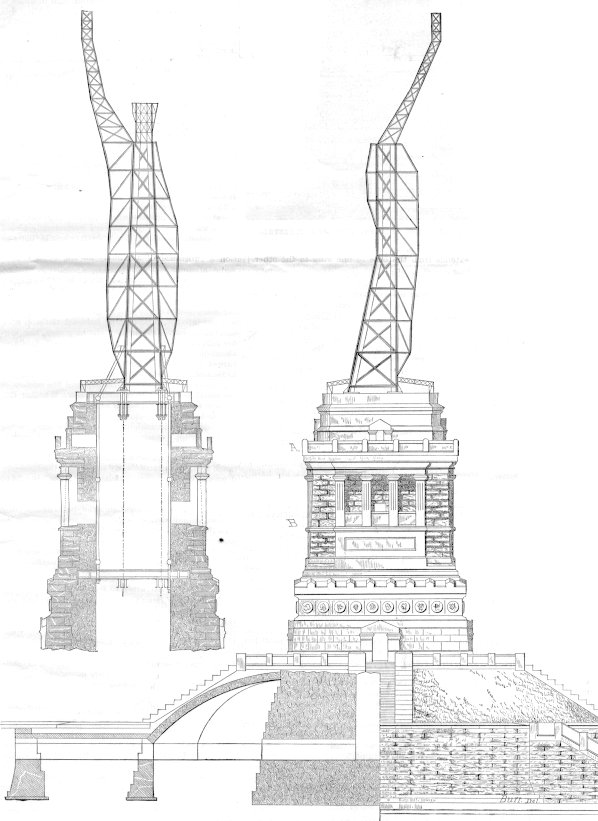Statue of Liberty
Today, a sneak preview of the Statue of Liberty. The University of Houston's College of Engineering presents this series about the machines that make our civilization run, and the people whose ingenuity created them.
I've been reading about the Statue of Liberty in a magazine. But this magazine is quite old. It's a Scientific American from June 13, 1885. The statue had set sail to New York from Rouen, in France, three weeks before. The cover picture on the magazine is an artist's impression of the Statue. In the picture, she looks far less solid and purposeful than the statue you and I know.
Scientific American becomes surer of itself on the inner pages. There we find schematic diagrams of the base and of the iron skeleton. Gustave Eiffel had designed the inner skeleton shortly before he turned his attention to the Eiffel Tower. The magazine tells how artist Auguste Frederic Bartholdi created the huge figure. First he sculpted her in a seven-foot model. Then he made an exact copy, roughly 35 feet tall. Finally he chopped that model into sections and enlarged each section by a factor of four. Then he shaped 3/32-inch copper plates to those pieces. Each plate was to be hung on the steel frame in such a way that it would impose no load on the other plates around it.
The article has a lot to say about size. The standard of comparison is the Colossus at Rhodes. The Colossus, one of the Seven Wonders of the Ancient world, stood just over a hundred feet tall on a jetty at Rhodes. Liberty is to stand 151 feet high. And, on her pedestal, she'll rise over 300 feet above the water.
Though Scientific American doesn't quote it, Emma Lazarus had already written her famous poem, The New Colossus. That's the one with the lines that appear on the statue today: "Give me your tired, your poor, your huddled masses yearning to breathe free, The wretched refuse of your teeming shore." The wording may have the ring of political incorrectitude, but the sentiment is still unique to our America.
 Less known are Lazarus' opening lines, "Not like the brazen giant of Greek fame, With conquering limbs astride from land to land." Never mind that the Colossus didn't straddle anything, the point is clear enough: America meant to reclaim the grandeur of the ancient world. The rest of this Scientific American issue has a lot to say about new kinds of heavy machinery. It pictures Booth's new flying machine -- an impractical one-man ornithopter that certainly never flew. Still, it's showing us America on the march.
Less known are Lazarus' opening lines, "Not like the brazen giant of Greek fame, With conquering limbs astride from land to land." Never mind that the Colossus didn't straddle anything, the point is clear enough: America meant to reclaim the grandeur of the ancient world. The rest of this Scientific American issue has a lot to say about new kinds of heavy machinery. It pictures Booth's new flying machine -- an impractical one-man ornithopter that certainly never flew. Still, it's showing us America on the march.
The Statue of Liberty is leaven in that loaf. She trumpets ideals that we've sometimes lived up to and sometimes failed to. She's the big news in this issue, and the news is important. The magazine dwells on nuts and bolts, tables of dimensions. But underneath it's clear this statue will become a new national metaphor. Emma Lazarus calls her the Mother of Exiles.
Grover Cleveland dedicated her the next year. The iron skeleton was now covered over and that lovely lady, clad in cuprous oxide, has called us to be what we all would hope to be, ever since.
I'm John Lienhard, at the University of Houston, where we're interested in the way inventive minds work.
(Theme music)
Liberty Enlightening the World. Scientific American, Vol. LII, No. 24, June 13, 1885.
Note Added Sept. 23, 2016: Student "Addie" points out that sources for this Episode from 1999 were out of date. Here are more current sources.
See the Wikipedia article on the Statue of Liberty.
Here is another good source.
I say a lot more about the statue in its context in my book Inventing Modern: Growing up with X-Rays, Skyscrapers, and Tailfins. Chapter 6.
From the 1885 Scientific American magazine.
Click on each of the thumbnails above for full-size images.
The linked photo at the beginning is by J. H. Lienhard

